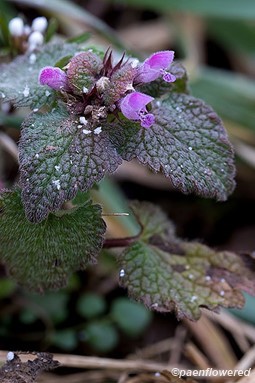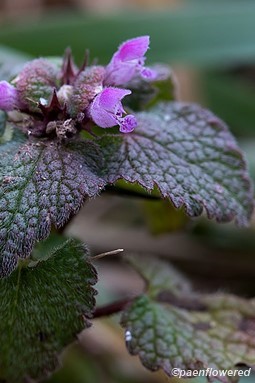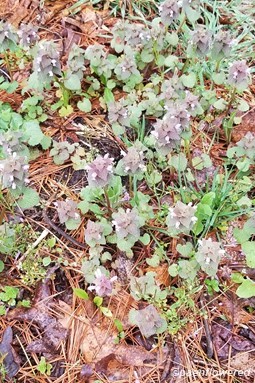Lamium purpureum
An omni-present European henbit with purplish-lavender flowers
Lamium purpureum purple deadnettle
This member of the mint family is native to Europe and Asia, but is a fast-spreading species in North America. It grows 4-12 inches high and is found on roadsides and other disturbed places. It is best recognized because the overlapping upper leaves of younger plants have a purple or reddish-purple coloration. On older plants this color turns to a dull green. These upper leaves may be more colorful than the tiny flowers. The purple dead nettle superficially resembles the unrelated stinging nettle plant, but have no ability to "sting", thus the name "dead nettle".
The purple dead nettle does well in areas where there is full sun. It is locally abundant and widespread. It has spread to almost all areas of North America except for particularly dry areas of the West. It also seems less common in the South. They often grow in colonies. The leaves are opposite and stalked and covered with tiny hairs. Each leaf can be up to 2 inches long and is finely pubescent. The netted veins are indented giving the leaf a wrinkly look. The leaves have short petioles. The stem is square in cross-section, another typical mint trait. The stem branches at the base.
The flowers are near the top of the flower spike that contains scattered tiny bright red-purple flowers that bloom only a few at a time. The flowers have a typical mint-like upper hood petal and a lower petal that is divided into two lobes. Small side lobes are reduced to small teeth. The hood is usually darker than the lower lip. The lower lip may be white with purple spots. The base of the flower tube has a line of tiny hairs. You need magnification to appreciate the real beauty of these little blossoms since they are a maximum of ½ inch long. They are pollinated by bees and are a major source of nectar for them. This species even can bloom during a mild winter, one of the few nectar sources available at that time. It is even possible for humans to pluck a flower and suck a drop of sweet nectar from the base. (Avoid doing this in areas that have been sprayed with chemicals.) The flowers are also self-fertile.
This species is often a winter annual, with seeds germinating in late fall. This allows the plants to flower early in the spring. The normal blooming period is March until October, but the plants may wither in the heat of midsummer. New plants may also bloom in the fall.
The leaves of the dead nettle are edible in salads, but do not have the best flavor. Finely chopped, the leaves can be used in sauces. It is seldom used in gardens because of its aggressive tendencies and the tiny flowers. It is considered an invasive weed by the U.S. Dept. of Agriculture. It is however not on the official PA invasive species list. It is also called purple archangel or the red dead nettle.
Habitat & Range
Grows by roadsides, in fields, open grounds & other man-disturbed habitats.
Present throughout the state.
Range: Found in all of North America except for particularly dry areas of the West.
Wetland code: Not classified
Phenology
Flowers April to October.











Comments
Have you spotted this plant in your area? We'd love to hear about your experience! Share your comments or questions about the plant below. Comments are moderated before posting.